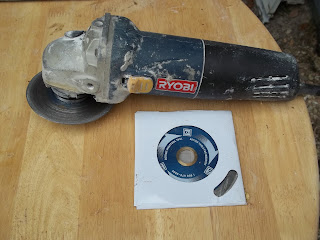The basic tools needed to lay tile are available at Home Depot, Lowes and most tile stores.
Tile tools are pretty cut and dry, and the basic set of essentials will cost you about $100. I've taken photos of my tools for this blog and these are not new tools They have been well used on a daily basis. These are the required tools to do a tile job in or around your home. The wet saw is included but not required. All the cuts can be made with the 4 inch grinder and the tile cutting machine
 |
Tools for Laying Wall and Floor Tile
Picture 1: notched trowels used to spread thinset on floors and walls .The notches allow for consistent thicknesses of thinset before you lay your tile. from left to right the first is a 1/2 notched trowel used for natural marble and slate tile, The second is a 3/8 inch trowel for large format floor tiles. The third is a 1/4 inch notched trowel, The most common used for floor and wall tile. Finally there is a finishing trowel for skin coating thinset smoothly on a surface.,
|
 |
Tile Tools: Stone Chipping Hammer, Margin Trowl,Tile Nippers
Picture two (2) shows from left to right, a stone chipping hammer for chipping concrete, flattening nails and basic hammering, which will be required every now and then. Then there is a margin trowel use for spreading thinset and mixing thinset in a bucket. The third tool is also a margin trowel bit it is a 1/4 inch notch margin trowel used to spread a consistent 1/4 inch thickness of thinset in corners and around edges. Finally there are tile nippers used to take small nips of tile off of the edge of cuts to make precise fits when cuts are just a bit too large to fit,
|
 |
12 inch speed square and 6 inch speed square plus 2 levels
|
Picture three (3) shows 2 speed squares. One is a 12 inch square and the other is a 6 inch square used to draw straight square lines on tile to make cuts. There are also pics of two levels . One 2 ft level and the other is a 4 ft level used to check rows of tile for levelness and also to keep lines straight.
 |
Bag of spacers. Used to keep tile staight and lines even
|
Picture four (4) shows a bag of spacers. These are very important in the tool bag for keeping tile straight and lines even.
 |
Hand broom, tape measure, grout float and razor knife tile laying tools
|
Picture five (5 ) from left to right : the all important hand broom to keep all surfaces free of debris and dust before laying tile, On top, the tape measure, used often . In the middle, the grout float used to grout finished tile. Finally, the razor knife to sharpen your pencil and also will be useful for many other tasks.
 |
4 inch grinder with a 4 inch diamond blade
|
Picture six (6). This picture is of a 4 inch grinder with a 4 inch diamond blade to cut tile. Very useful on the job and will cut tile ,stubborn toilet bolts, copper pipe, steel nd just about anything that hampers you from laying flat tile.
 |
Hand Tile Cutting Machine
|
Picture severn (7) is a hand tile cutting machine for straight tile cuts and may take some time to master its use but will really be helpful along walls where many cuts the same size are needed.
 |
Tile Cutter
|
Picture 8: Another view of a tile cutter
 |
Tile Cutter Ready to Cut Piece of Ceramic Tile
|
Picture nine (9) a side view of a tile cutter with a tile on it ready to be cut
 |
Wet Saw Used by Professional Tile Installers
|
Picture ten (10) is a wet saw used mostly by a professional tile installer and needed for any marble installation.
 |
Picture of Wet Saw
|
Picture 11. Another view of the
wet saw
 |
7 inch diamond bladee wet saw
|
Picture 12: Final picture of
wet saw equipped with
7 inch diamond blade
 |
Bucket for water and mixing thinset.
|
 |
Sponge Used in Laying Tile
|














